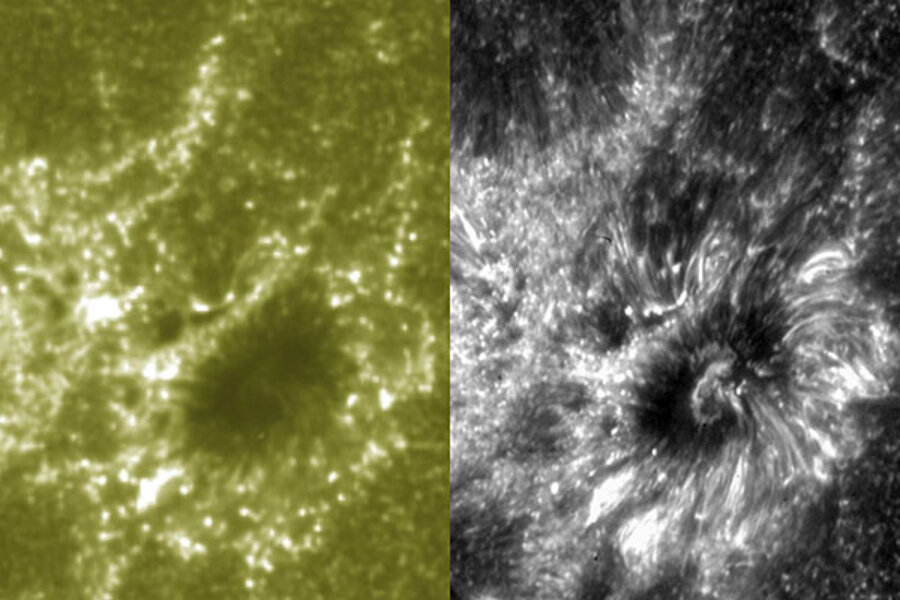New IRIS telescope sends stunning images of sun to befuddled scientists
Loading...
A new solar observatory, launched less than a month ago, is revealing remarkably fine details about a little-explored region of the sun's atmosphere, where temperatures leap from tens of thousands of degrees Fahrenheit at the sun's surface to to millions of degrees in its extended atmosphere.
Dubbed the interface region by the observatory's science team, this first 2,000 to 3,000 miles of the sun's atmosphere is thought to play a key role in a range of processes, including those that power solar flares and even more potent coronal-mass ejections. These events can endanger satellites, disrupt radio communication and GPS navigation, as well as disrupt the power grid on Earth.
For all their excitement at seeing the first images from this new orbiting observatory, mission scientists aren't quite ready yet to hazard informed guesses about what the new observations mean.
"I'm not brash enough to tell you what new and exciting things there are, but there are enough hints that people are very excited," said Alan Title, a solar physicist with aerospace giant Lockheed Martin and the lead scientist for NASA's Interface Region Imaging Spectrograph (IRIS), during a briefing Thursday.
In general, the team has been surprised "that there is so much structure in areas that are relatively quiet" on the sun's surface, Dr. Title said, referring to small-scale regions of varying temperatures and looping eruptions of hot gas. "We're seeing a lot more structure than we anticipated."
The 400-pound telescope, launched on June 27, taps ultraviolet light from the sun's interface region to take detailed images and spectra of features as small as 150 miles across.
That capability represents a 10-fold improvement in picking out fine details, compared with previous solar observatories operating at ultraviolet wavelengths, mission officials said. And the instrument gathers images and spectra 20 times faster than its predecessors, allowing researchers to capture events that would have been too fleeting to see before.
The interface region actually encompasses what typically has been thought to be two layers of the solar atmosphere – the lowest layer, or chromosphere, capped by a region less than 200 miles thick dubbed the transition region.
Over the past decade, however, solar physicists have come to recognize that this onion-skin-like picture is less than tidy, explains Jeffrey Newmark, a solar physicist at NASA headquarters in Washington.
Today, theorists suggest that the interface region is characterized by constant eruptions throughout the chromosphere of hot gas in a random, geyser-like fashion on small scales all over the sun's surface.
"We think it's these smaller-scale jets and waves that propagate through these jets" that send the atmospheric heating process on the sun into overdrive, Dr. Newmark says. That rapid increase can occur with a change in altitude of less than 600 miles.
During the briefing, researchers unveiled images of a small sunspot and a small active region where hot gas erupted from the sun. In addition, the researchers presented some initial data from the observatory's spectrograph.
The spectra yield information on temperature, pressure, and the velocity of features moving across or erupting from the sun's surface. These allow researcher to unpack the physics behind the processes at work in the interface region.
The team also hopes to monitor long-term trends in solar activity, in coordination with observatories that can provide the big picture for events such as solar flares and prominences, even as IRIS captures what's happening on small scales.
The spectra the team released Thursday showed intense emissions from magnesium atoms forged in the sun's fusion furnace.
By tracking the intensity of those spectral lines over time, the team can track changes in the sun's brightness at ultraviolet wavelengths – changes that have an impact on Earth's climate through their influence on temperatures and circulation in the stratosphere.
"We want to see how the brightness of the sun in these ultraviolet lines changes as a function of the solar cycle," said Bart DePontieu, also a solar physicist with Lockheed Martin.








